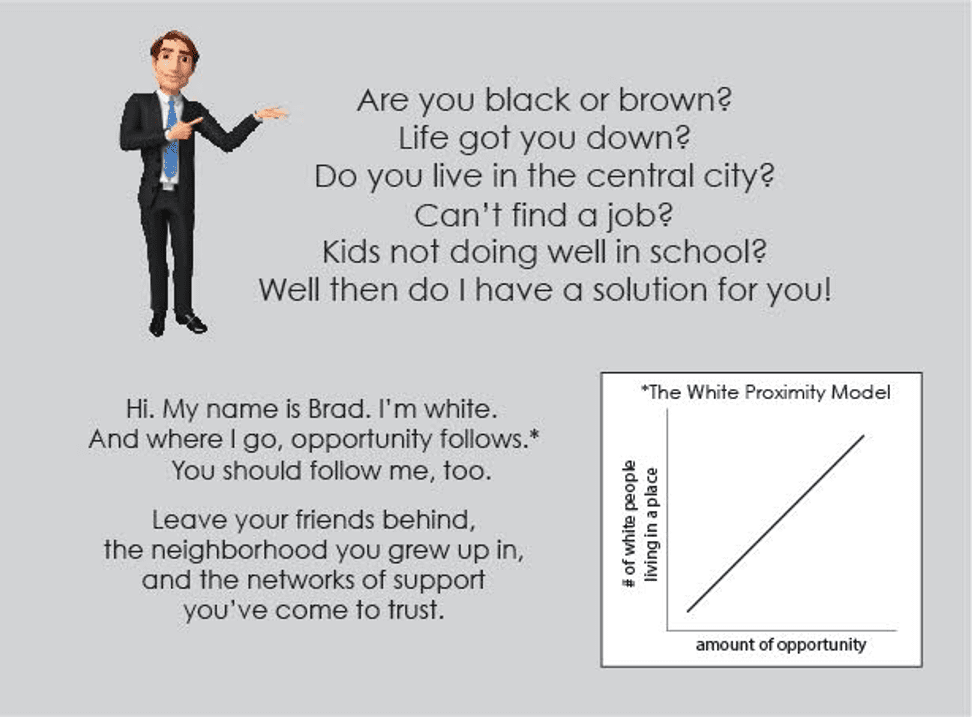
Photo by unefunge via flickr, CC BY-NC-ND 2.0
In 2015, fair housing lawyers filed a complaint with HUD against the cities of Minneapolis and St. Paul, and the state of Minnesota, alleging that they had failed in their obligation to affirmatively further fair housing by building a disproportionate amount of affordable housing in high-poverty communities of color. The allegation in the complaints was that affordable rental housing was being intentionally concentrated in segregated, “low-opportunity” neighborhoods of color. The challenge echoed previous cases in other parts of the country in which fair housing activists complained that too much tax-credit housing going into minority neighborhoods. In the Twin Cities, however, a coalition of place-based, housing, and advocacy groups, based in the very neighborhoods alleged to have been harmed, pushed back.
The coalition, called Equity in Place (EIP), claimed that none of the organizations initiating the challenge had the right to speak on behalf of the communities named in the lawsuit. For example, three of the complainant organizations were Minneapolis neighborhood groups whose staff and complaint boards were disproportionately composed of white homeowners despite representing diverse neighborhoods with significant amounts of rental housing. This question of representation—especially in wealth, race, and ethnicity—caused EIP organizers to immediately voice concerns about the complaint. As one organizer explained, “This began to raise alarm bells. It was like they were doing this over our heads, without us.” EIP activists felt the fair housing complaint illustrated how low-income communities of color are sidelined in conversations around housing justice and how the vulnerable status of the communities is used to discredit the knowledge of residents and their organizers in issues pertaining to their own communities.
It was more than demographic representation, however, that alienated many of the member organizations in the EIP coalition. Organizers objected to the narrative around low-wealth communities of color that accompanied the complaint. As one EIP activist wrote,
“The narratives about these neighborhoods usually focus on the negative: their poverty, low-performing schools, etc. Through our work and experience, however, we know that the people who live in these communities benefit from the cultural connections and social networks they create… In my community of Brooklyn Park and Brooklyn Center [two northern, inner-ring suburbs of Minneapolis], which have some of the fastest growing Racially Concentrated Areas of Poverty, there are many ethnic microbusinesses—immigrant-owned enterprises that provide culturally specific goods and services—that are able to thrive because of the critical mass of immigrant residents.”
According to EIP, “The complaint assumed that affordable housing investments contribute to too many people of color living in poor communities,” while ignoring “the historical and present-day institutional and structural racism that forced people of color into those communities.”
EIP first emerged in 2013, in response to the Metropolitan Council’s decennial regional plan, Thrive MSP 2040. The Metropolitan Council is the regional planning body of the Minneapolis-St. Paul metropolitan area and Thrive MSP 2040 is the council’s 30-year growth plan (which it creates anew every 10 years). Ahead of Thrive MSP 2040, the Council conducted a Fair Housing Equity Assessment that, in accordance with HUD’s directives, emphasized the identification of both “racially concentrated areas of poverty” (RCAPs, later amended by HUD to RECAPs—racially/ethnically concentrated areas of poverty) and “high opportunity areas.” Thrive MSP 2040 defines RCAPs as census tracts where 50 percent or more of the residents are people of color and 40 percent or more of the residents have family incomes that are less than 185 percent of the federal poverty threshold. Opportunity areas were defined by the proximity of jobs, high-performing schools, environmental quality, safety, and access to social services and basic necessities.
To members of the EIP coalition, the focus on RECAPs and the entire narrative around RECAPs portrayed the region’s most diverse communities as problematic areas requiring improvement. EIP organizers created a three-pronged response: regarding narrative, EIP wanted to challenge the dominant storyline that portrays RECAPs as the central problem of regional equity; in policy terms, EIP wanted to challenge the dominant housing strategy that focused on moving people to “opportunity neighborhoods”; and, in political terms, the group demanded a place at the table for low-wealth communities of color when decisions about those communities are being made. Most fundamentally, EIP wanted to redefine regional equity in ways that include “building the economic, cultural, political, human and social capital of the places people of color already call home”
From the outset, EIP members questioned the “opportunity” framework that the federal government was imposing on the regional equity assessment. Between 2013 and 2020, a central element of EIP’s work was investigating the unstated assumptions of this opportunity framework and expressing them in easily understood language. The racialized framing of “opportunity” was a particular emphasis for the group, with backlash against notions of racial “tipping points” and “racial concentration” inherent in the RECAP definition. EIP activists pushed back by offering two specific reframings, the “white proximity model” and the “racially concentrated area of affluence” (RCAA).
The “White Proximity Model.” After a Metropolitan Council meeting in 2015 in which racial “tipping points” were cited to support a concern that neighborhoods should not have “too many” people of color, three EIP activists came up with the concept of the “White Proximity Model.” The White Proximity Model tries summarize how the federal government’s opportunity framework plays out in reality and the mobility policy recommendations that result from it. As Figure 1 depicts, the idea of opportunity was, in the eyes of the EIP activists, frequently associated with whiteness. This implicit assumption that portrays predominantly white places as high opportunity areas further stigmatizes low-income communities of color while hiding the structural forces that perpetuate racial inequality. The graphic is an attempt to distill and amplify what EIP saw as the paternalistic and racist assumptions embodied in the opportunity paradigm and in mobility policy, and to make it visually obvious. While the problematic logic of the white proximity mindset was apparently obscure to fair-housers and policymakers, its dog whistles were deafening to EIP and the constituents it represented.

Figure 1: The White Proximity Model. Image provided by Ed Goetz
With the introduction of the “white proximity model” into the vocabulary of local planning and policymaking in the Minneapolis–St. Paul region, EIP caused a conceptual and narrative shift where whiteness could no longer hide behind the disguise of “opportunity.”
Racially Concentrated Areas of Affluence. EIP activists also attacked the preoccupation of policymakers, both federal and local, with RECAPs. As one EIP activist indicated during the 2040 regional planning process, the group:
“Highlighted the failure of systems to name racially concentrated areas of wealth as also being segregated, as these tend to be mainly affluent white communities. In identifying areas with white concentrations of wealth, we sought to dispel the myth that some areas are poor because people of the same race live together and that certain races prosper when they live together. The real reason why communities of color living together are poor is because of the discrimination that occurs when these communities choose to live together, and that is what needs to be solved for.”
Racially concentrated areas of affluence (RCAAs) are more than just the other end of the segregation continuum in American metropolitan areas. They represent the economic benefits of living in predominantly white places, and they highlight the importance of examining wealthy, white places in particular. EIP’s goal in naming RCAAs as a topic for analysis was to reveal widely held policy positions that assume “the normality and superiority of White middle-class space.”
By introducing RCAAs into their advocacy work, EIP succeeded in broadening the scope of fair housing analysis in the Twin Cities, producing a situation in which a fair housing analysis had to account for segregation at both ends of the continuum. The concept of RCAAs became a way for advocates to assert that the forces that produced concentrations of poverty were the same that produced concentrations of wealth and to force an analysis that acknowledged both the value of existing low-wealth communities of color and the problems associated with concentrated white affluence.
Shifting the Narrative about Fair Housing
Soon after the fair housing complaint was filed in 2015, EIP members began a campaign to pressure both regional and national HUD officials for a seat at the table as the complainants negotiated with local officials of Minneapolis and St. Paul. Strategies included a letter-writing campaign as well as a meeting with then–HUD Secretary Julian Castro and HUD Region 5 officials. EIP also took time to meet with several state legislators who had signaled their support of the complaint. The goals of these encounters were to explain to these officials that the complainants did not represent residents who were most affected and that those residents had not been granted a seat at the decision-making table, and to advocate for a process that included communities of color. HUD was receptive to these concerns and agreed to include EIP in the resolution of the complaint.
The parties reached an agreement in May 2015 to amend the 2014 Regional Analysis of Impediments (AI), a document HUD used to require of local grantees. In the past, the AI process was performed solely by local government officials from the 13 entitlement districts located in the Twin Cities metro area.
As one governmental official involved in the process said, “Typically, [the fair housing committee] consisted of … white bureaucrats sitting around a table. Again, if you are thinking about this from the standpoint of, ‘Oh, this is something we have to do,’ as opposed to, ‘How do we do this in a way that’s as meaningful as it can be?’ … It shouldn’t be those 12 people making decisions necessarily, around how we identify barriers to fair housing.”
Due to the concerns of EIP, as well as HUD’s interest in ensuring the viability of the process, a Fair Housing Advisory Committee (FHAC) was formed. The FHAC was a first-of-its-kind committee that would advise in writing an addendum to the AI. The final make-up of the FHAC consisted of five members representing local governments, four representing the complainants, four representing EIP, and the remaining 10 participants chosen by facilitators from organizations not aligned with any of the above groups.
The FHAC met 12 times between March 2016 and May 2017. At the core of these conversations was a heated discourse between differing visions of fair housing and regional equity. The complainants felt that their neighborhoods already had their “fair share” of affordable housing and they claimed that more subsidized housing in those neighborhoods would further concentrate poverty. EIP, on the other hand, aligned themselves more closely with the view that while mobility is important, it is also important to build affordable housing in disadvantaged communities that often disproportionately suffer from poor housing conditions, disinvestment, and high housing cost burdens on the one hand, and are vulnerable to gentrification and displacement on the other.
EIP had a significant impact on the process and was able to achieve several important wins during the AI Addendum planning process. First, they were able to persuade others on the committee about the problematic framing of communities of color using narrative storytelling and personal experience. One housing organizer from the Frogtown neighborhood in St. Paul shared with FHAC members problems that she had had with housing stability in her own life. She talked about how her family had been displaced multiple times in the past several years. She noted that she did not have a choice to move but was constrained by living wherever she could afford.
“Most wealthy people don’t have to think about those things,” she said. “Frogtown is beautiful and the culture is vibrant and now outsiders get to choose to replace me. Talking about race and why people of color or people with low incomes feel dispossessed as if resources dictate their decisions for them, is a critical aspect of the conversation.”
In addition to centering disadvantaged communities and their history, EIP influenced the outreach and engagement part of the planning process. Instead of hiring a single outside consultant to lead the engagement process, EIP insisted instead that organizations with preexisting ties to the community be used, arguing that this would improve trust and the quality of engagement. The coalition secured $71,000 in micro-grants for community organizations throughout the Twin Cities to engage low-wealth communities of color as well as immigrant communities. Organizations participating in the FHAC that represented immigrant communities noted that many of their constituents are undocumented and that they would feel more comfortable voicing their concerns to trusted voices rather than to an unknown outside facilitator. EIP noted in its evaluation of the process that “with more local control and less reliance on generic narratives, we could better challenge the … narrative that segregation was the main fair housing issue in the region. Instead, we elevated the real concerns of people of color.”
To EIP organizers, gentrification and displacement were fair housing concerns, and they fought for those issues to be considered by the FHAC as fair housing issues. In the view of the coalition members, the original AI focused almost exclusively on concentrated poverty and neighborhood decline while ignoring how gentrification disproportionately affects communities of color and the ability of people of color to remain in their neighborhoods. It took the efforts of EIP to broaden the scope of the discussion about what issues should and should not be considered a part of fair housing. As a result, the final recommendations for the AI Addendum included specific policy goals to mitigate gentrification and displacement.
EIP’s work has had concrete impacts on the conversation around regional equity in the Twin Cities of Minneapolis and St. Paul. EIP was able to effectively undermine the stigmatizing narrative of concentrated poverty and the unstated assumptions behind the opportunity paradigm. Both the white proximity model and the concept of RCAAs helped to reset the regional conversation, directing policymakers away from an exclusive focus on low-wealth communities of color. Politically, EIP activists were able to get community residents to the decision-making tables for a range of policy areas from transportation and sustainability to housing. Their work has produced policy impacts as well. The group was able to convince federal housing officials to broaden and to deepen their understanding and analysis of regional inequities, to expand notions of acceptable policy response beyond mobility, and to see the issue of segregation as more than “racially concentrated areas of poverty.” All of these accomplishments served to raise more fundamental questions of discrimination and power differentials in regional equity policymaking.
This article is based on a longer essay published in What Works to Promote Inclusive, Equitable Mixed-Income Communities, a volume edited by Dr. Mark L. Joseph and Dr. Amy T. Khare, part of the Federal Reserve Bank of San Francisco’s What Works series.




This is an old, but still relevant, debate. 20 years ago, I was working with non-profits to redevelop the boarded buildings in Over-The-Rhine in Cincinnati with federal housing and historic credits and, given that circa 2000, the area was almost entirely very poor and Black, the concentration of poverty question was front and center. There were 2 things that convinced me it was worthwhile, beyond the dedication of the developers: 1) the same argument made by EIP, that preserving one’s neighborhood network of supports has real value; and 2) since it was so centrally and desirably located adjacent to downtown Cincinnati, the area was likely to rebound eventually. 20 years later, with gentrification underway, it looks better now that we “reserved” some housing for poor people in the neighborhood. Communities do evolve. Both sides in this debate are right. Low-income and minority households need choices.
There’s quite a debate. But Christian Community Development Association, which I’m connected with, has always stood for improving communities in place.
The debates about “moving to opportunity” vs. place-based investment are so often raging between white middle-class community development professionals (myself included), so it’s refreshing to read about a case where people in impacted neighborhoods assert themselves. In this case, it seems like they want to reshape the realities that Nikole Hannah-Jones aptly described in a previous Shelterforce article:
“The argument for proximity to whiteness is not that there’s something magical about white people. When I talk about [proximity] in schools and in housing, what it does is guarantee that Black folks get the same things that a country built on white supremacy guarantees for white Americans. … We have always been willing to accept certain circumstances for Black people that we would never accept for white people. I wish we had found another way where this country would simply value Black people the same, and Black people did not have to have proximity to white people to get these things, but it’s just simply not true.” https://shelterforce.org/2018/02/06/interview-nikole-hannah-jones/
There is no reason why a physical solution of continuing “better but separate neighborhoods” needs to be the solution to segregation. But it is probably not laws but, rather, changing minds about what races think of each other is the better strategy. Voluntary and intentional integration needs to be the method. Think of the George Floyd demonstrations as an example. That’s the path that young people are following, maybe not intentionally, but the interaction is the vehicle. Races who are are not strangers to each other begin to think that “the other” is not a target for fear. My kids were fortunate to attend a public school with a mixture of races close to the regional proportions of races. They were shocked to see that their college experiences were much less integrated. They had friends of other races but did not find those relationships as they got older.